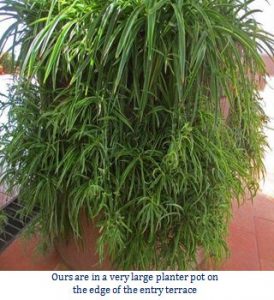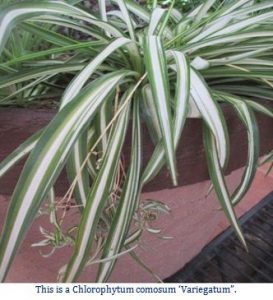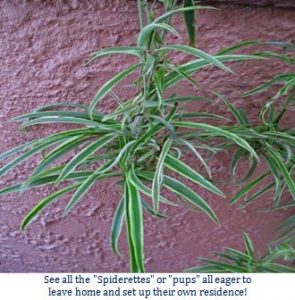By Tommy Clarkson from the July 2016 Edition
Family: Arecaceae
Also known as: Airplane Plant, Spider Ivy, Ribbon Plant, St. Bernard’s Lily and Hen and Chicks
The Spider Plant is one of the most popular of all indoor plants or can be equally effectively used out of doors in a variety of venues.
It is exceedingly resilient and easy for which to care.
Secondly, (for all those who are greatly “green”) it gobbles up airborne benzene, formaldehyde, carbon monoxide and xylene. (That latter one is a solvent used in the leather, rubber and printing industries.) Thirdly, it is easy to propagate. And lastly, wholly lacking in toxicity, it’s considered a safe houseplant for pets.
Originating in South Africa, a mature specimen can form a clump three feet (0.9 meters) tall, cascading out as much as five feet (1.5 meters). This sun-loving, evergreen, perennial has slender, arching, linear dark green leaves with creamy white stripes between 8-16 inches (20.3-40.6 cm) long and less than 1 inch (2.5 cm) wide. (Take note: They like lots of light to attain and maintain the best leaf color. Specimens grown in low light may lose their attractive variegation.)
 Borne on outward arching, wiry stalks (called runners) are small white flowers. These give rise to seed filled capsules, after which baby spider plants (sometimes called “spiderettes” or “pups”) develop on the stalks taking root wherever they touch the ground.
Borne on outward arching, wiry stalks (called runners) are small white flowers. These give rise to seed filled capsules, after which baby spider plants (sometimes called “spiderettes” or “pups”) develop on the stalks taking root wherever they touch the ground.
Generally speaking, one really can’t cramp their style as they like to be slightly root-bound. When they are, they’ll optimally flower and produce plantlets best. And as to feeding them too much (those are the operative two words) fertilizer will produce a lot of leaves, but minimal flowers and plantlets. I’d suggest feeding them every two weeks (if in our tropical environs) with a liquid fertilizer that’s been diluted by half. As to watering, some growers advise to keep the soil evenly moist at all times. However, I prefer to let it slightly dry between watering.
To best show off their trailing foliage, Spider plants look great on pedestals or in hanging baskets. Ours are well presented in an extremely large pot surrounding a magnificent Emperor Cycad in front of our Dining Palapa.
But they not need be left solely to themselves. The slender, arching variegated leaves and graceful, fountain  -like growing habit present a most attractive contrast and texture when grouped with other house plants.
-like growing habit present a most attractive contrast and texture when grouped with other house plants.
Chlorophytum comosum prefer to be semi-pot bound. Accordingly, wait until their large, fleshy roots are highly visible and watering is difficult to re-pot.
A few tips are as follow:
- Should you note the leaves appearing dull and grayish with webs underneath, you have red spider mites. Treat accordingly.
- If your plant is rotting in its center you’ve been overzealous in watering it. Allow your ailing friend to dry out before giving it another drink.
- Upon noting that the tips of leaves are turning brown, ensure you are not giving it water in which fluoride has been added. It not, then it is either too dry or is receiving too much direct sunlight.
- If your plant looks floppy and dull it probably will benefit from the use of a balanced liquid food.
- Weak and lanky leaves that have become dry and lost their color are indicators that it is too hot and dry. Move and/or water accordingly.
- And, it’s time to repot the parent plant (and remove extra babies) if the plantlets are pulling the parent to one side.
There are numerous different cultivars (varieties) of the Chlorophytum comosum. What is thought to have been the original has green leaves with a slightly lighter green shade running through the center. Actually, it prefers the shadier areas (no, not south of the tracks or dark, sleazy alleyways) than the variegated versions. These seem to be getting increasingly hard to find in nurseries or garden centers.
Chlorophytum Comosum “Vittatum” was the first variegated Spider Plant cultivar having mid-green leaves with a broad central white stripe. From its long stems hang yellow/white “babies.
Chlorophytum Comosum “Variegatum” is the botanically “new and improved”, more compact, version with dark green leaves and white margins and long green stems which support the offsets.
Chlorophytum Comosum “Bonnie” has leaves of the traditional green with white stripe variegation but they curl and bend. Its flowering stems are yellow. Some, with limited space, prefer this type as it doesn’t require a large area to show off its attractiveness.
Whichever cultivar you choose, if you have a brown thumb, this is a great plant for you!
Download the full edition or view it online
—
Tommy Clarkson is a bit of a renaissance man. He’s lived and worked in locales as disparate as the 1.2 square mile island of Kwajalein to war-torn Iraq, from aboard he and Patty’s boat berthed out of Sea Bright, NJ to Thailand, Germany, Hawaii and Viet Nam; He’s taught classes and courses on creative writing and mass communications from the elementary grades to graduate level; He’s spoken to a wide array of meetings, conferences and assemblages on topics as varied as Buddhism, strategic marketing and tropical plants; In the latter category he and Patty’s recently book, “The Civilized Jungle” – written for the lay gardener – has been heralded as “the best tropical plant book in the last ten years”; And, according to Trip Advisor, their spectacular tropical creation – Ola Brisa Gardens – is the “Number One Tour destination in Manzanillo”.




